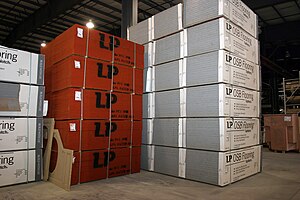
- Image via Wikipedia
Yesterday, I wrote a post about Coach-Built cars of the 1920s and 1930s. As I was wring about those cars, and the Coach-Builder catalogs that grew out of them… and the mass-produced cars, I started thinking about the comparison with homes in the US. And there is an interesting comparison.
Back in the 1970s and 1980s, my grandparents had a wonderful lake property in northern Michigan. It was on Black Lake. It had been in the family (mostly) for generations. When I was very young, it had a couple of one room cabins that had been built in the 1930s. There was no running water or indoor plumbing.
But then, in the early 70s, my grandparents had a double wide mobile home put on the lot. It wasn’t a palace, but it was WAY nicer than the little cabins in replaced. And it cost MUCH less than having a “regular” home built on the lot.

- Image via Wikipedia
There is a stigma with manufactured housing, though. It isn’t just “some people”, either. Some lenders won’t finance a manufactured home. Others have a much higher rate.
And those are kind of like mass-produced cars… built on an assembly line… using components that are often tailored specifically for them. Constructions is actually VERY streamlined. The parts fit, so it is largely a matter of assembling all of the pre-made components. It is efficient… less waste… less time… even less energy.
On the other end of the scale are custom homes. There are a couple of flavors, but for the purposes of this discussion, we’ll lump any home built completely on-site as being custom built. That would be the vast majority of homes. And it is a terribly inefficient process. Just think about it…
-

- Image via Wikipedia
coordinating dozens of contractors to come out at just the right time
- coordinating multiple inspections of the property… at just the right time.
- while there are efforts made at maximizing the usage of the purchased materials, building one house at a time can’t utilize materials as well as mapping them out for multiple builds.
- engineering for one home, or even a small run of similar homes, can’t be as rigorous as it can be for a mass-produced run.
- same with design…
Honestly, I’m not really a cheerleader for pre-manufactured housing… but I can see some writing on a distant wall. At some point, the efficiencies of manufactured or component housing will outrun the deficiencies. Lowering the cost and speeding the build-time, along with increasing the energy efficiency, space utilization and material efficiency will move in front of tradition.

- Image via Wikipedia
Already, in various places around the world, component housing is picking up steam. And I think it is only a matter of time until the idea catches on here. In effect, a buyer could choose from the components that they want to make up a home… plug in various parts of the plan… add an extra bedroom, media room or garage space as the home is being designed… plug and play. The various parts would be assembled in a factory, and then shipped to the location. At that point, the house would basically be joined together. (Have you ever seen a Bruster’s Ice Cream Shop or Nathan’s Hot Dog store being installed? They come on a truck and the property goes from being a parking lot and a pad to having a building in a day).
Another option is that similar to the log home kit model. Most log homes are built from kits. The vendor literally builds the shell at the mill, makes all of the adjustments to the structure, then disassembles and ships the parts… numbered like a puzzle… to be built on the site. That might be an intermediate step…
As I said… it is only a matter of time… but that could be a generation away.
Related articles
- The New Pricey Prefabs (blogs.forbes.com)
- Glass, the newest material for extra-sturdy homes (seattletimes.nwsource.com)
- Mobile-Home Makers Try To Stitch Together a Rebound (online.wsj.com)
- UFPI Increases Sales by 5% in 3rd Quarter 2010 Despite Weak Economy (eon.businesswire.com)

